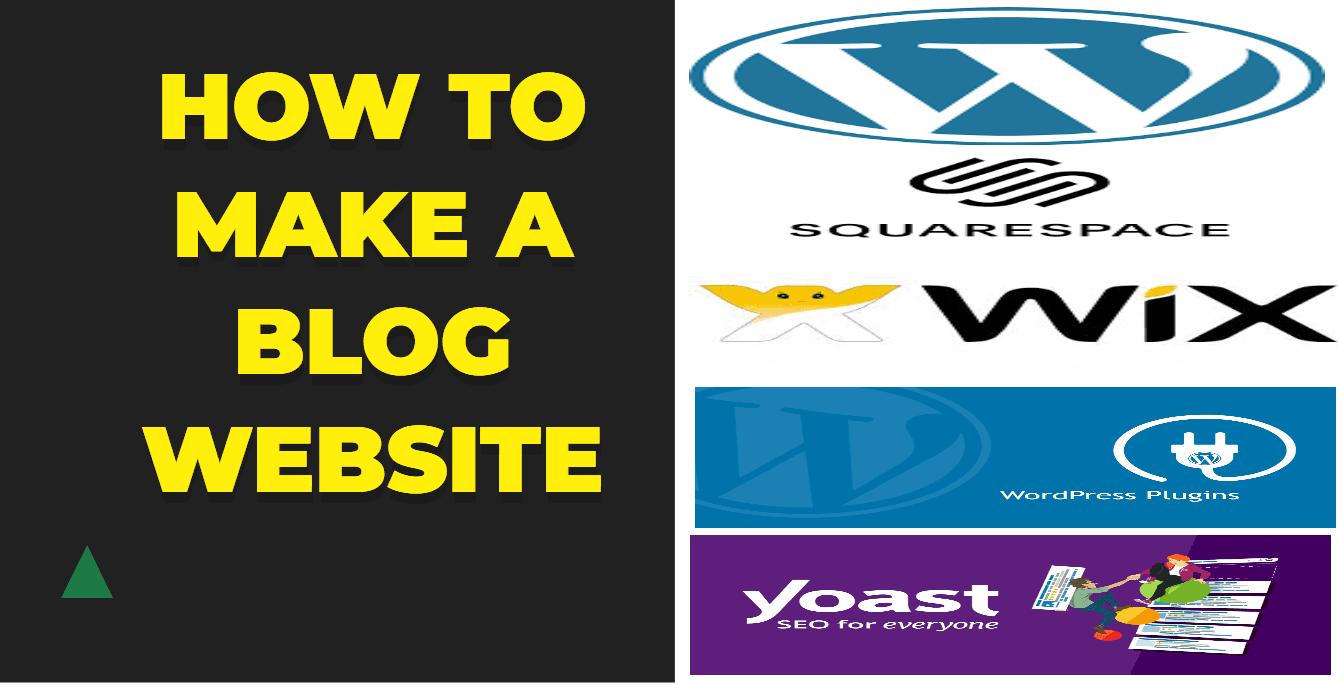Creating a Blog website is easier than ever, thanks to a variety of user-friendly tools and platforms. Whether you’re starting a personal blog, building a professional portfolio, or launching a business blog, this guide will walk you through the steps needed to create your very own blog website. Here’s everything you need to know to get started.

Following are the steps to make a blog website
Contents
1. Choose a Blogging Platform
The first step in creating a blog website is selecting the right platform. Popular platforms include WordPress, Squarespace, and Wix. Each has its pros and cons, but for most bloggers, WordPress.org is the most flexible and powerful option.
Popular Blogging Platforms:
- WordPress.org – Free, highly customizable, with thousands of themes and plugins.
- Squarespace – User-friendly with drag-and-drop functionality and attractive templates.
- Wix – Easy to use, but limited customization compared to WordPress.
Choose the one that best suits your technical skills and needs.
2. Pick a Domain Name and Hosting Provider
Once you’ve selected your platform, the next step is choosing a domain name (your blog’s address on the web) and a web hosting provider (the service that stores your blog).
Tips for Choosing a Domain Name:
- Keep it short and memorable.
- Avoid hyphens and numbers.
- Include keywords relevant to your niche.
Best Hosting Providers:
- Bluehost – Affordable, easy integration with WordPress, and beginner-friendly.
- SiteGround – Known for fast performance and strong customer support.
- HostGator – Offers a variety of plans, ideal for both beginners and experts.
After purchasing your domain and hosting, you’ll need to connect them and install your blogging platform (WordPress, for example).
3. Install WordPress and Select a Theme
If you’re using WordPress, most hosting providers offer a one-click installation option. After installation, you can choose a theme that reflects your blog’s purpose and style.
How to Choose the Right Theme:
- Consider your niche: Choose a theme that suits the content of your blog.
- Prioritize mobile-friendly designs: Most visitors will access your site via mobile devices.
- Opt for a lightweight theme: This will improve your site’s loading speed.
There are thousands of free and premium WordPress themes available, so you’ll have plenty of choices.
4. Customize Your Blog’s Design
Once your theme is installed, it’s time to customize it to make your blog look unique. You can do this by tweaking fonts, colors, and layouts. Most themes allow easy customization through a drag-and-drop editor or through WordPress’s native customizer.
Essential Customization Tips:
- Header and Logo: Add a custom logo to brand your blog.
- Menus: Organize your content with clean, easy-to-navigate menus.
- Sidebar: Include widgets like search bars, recent posts, or categories.
A well-designed blog enhances user experience and makes your site visually appealing.
5. Install Essential Plugins
Plugins are add-ons that enhance the functionality of your blog. WordPress has an extensive library of plugins that allow you to add features like contact forms, social media sharing buttons, and SEO optimization tools.
Must-Have WordPress Plugins:
- Yoast SEO: Helps optimize your content for search engines.
- Jetpack: Provides security, performance, and site management tools.
- WPForms: Easy-to-use drag-and-drop form builder.
- Social Warfare: Adds beautiful, customizable social sharing buttons.
Choose plugins that add value to your blog without overloading it with unnecessary features.
6. Create Quality Content
Now that your blog is set up, the next step is to start writing and publishing content. Quality content is what will attract readers and keep them coming back to your blog.
Tips for Writing Blog Posts:
- Choose topics that resonate with your audience: Focus on your niche and solve common problems or answer questions.
- Use catchy headlines: The headline is the first thing readers see, so make it interesting.
- Optimize for SEO: Use keywords naturally in your posts, and include internal and external links.
Plan a content schedule and publish consistently to build readership.
7. Optimize Your Blog for SEO
Search engine optimization (SEO) is crucial for driving traffic to your blog. To rank higher in search engines, you need to optimize both your content and website structure.
SEO Best Practices:
- Use relevant keywords in titles, meta descriptions, and headings.
- Optimize images with descriptive file names and alt text.
- Improve page speed by compressing images and using a caching plugin.
- Include internal links to keep readers on your site longer.
SEO takes time, but with consistent effort, your blog will start attracting organic traffic.
8. Promote Your Blog
Once your blog is live, promoting it is essential to attract readers. There are several ways to market your blog effectively.
Blog Promotion Strategies:
- Social Media: Share your blog posts on platforms like Facebook, Instagram, Twitter, and LinkedIn.
- Email Marketing: Build an email list and send newsletters to engage your readers.
- Guest Blogging: Write guest posts for other blogs in your niche to reach a broader audience.
The more you promote your blog, the more visibility and traffic you’ll gain.
9. Monetize Your Blog
If you’re looking to earn money from your blog, there are multiple monetization strategies you can explore.
Ways to Monetize a Blog:
- Affiliate Marketing: Promote products or services and earn a commission for every sale made through your links.
- Sponsored Content: Partner with brands to write sponsored posts.
- Ad Networks: Use platforms like Google AdSense to display ads on your blog and earn revenue from clicks.
Monetization takes time and traffic, so focus on building a strong content base before expecting significant earnings.
10. Maintain and Grow Your Blog
Once your blog is up and running, you’ll need to maintain it by regularly updating plugins, backing up your site, and improving your content strategy. Monitor your blog’s performance using tools like Google Analytics to understand your audience and identify areas for improvement.
Tips for Blog Maintenance:
- Regular Backups: Ensure you have backups of your site in case of technical issues.
- Content Updates: Keep your older blog posts updated with fresh information.
- Engage with Readers: Respond to comments and emails to build a loyal community.
Continually improving your blog’s quality and performance will help you grow your audience over time.
Conclusion
Building a blog website is an exciting and rewarding journey. By following these steps, you can create a professional, user-friendly blog that attracts readers and grows over time. Whether you’re blogging as a hobby or for business, consistency, quality content, and SEO optimization are key to your success. So get started today and watch your blog flourish!

Find the best online schools in Illinois, compare programs and tuition.
Earn your degree from a reputable online school in Illinois.
Flexible schedules and convenient online classes.
Begin your online schooling adventure now.
Online schools offering a wide range of programs.
Approved online colleges in Illinois.
Cost-effective online programs in Illinois.
Online programs with excellent student outcomes.
Boost your resume with an online certification in Illinois.
Connect with like-minded individuals in online programs in Illinois.
Online Schools in Illinois https://www.onlineschoolil20.com .
lasix 100mg We focused on the 313 genes that showed high ranks in both expression and fold change in our RNA seq result expression level 3000 RPKM, fold change 10
Explore the top online education options in South Carolina, Earn your degree without ever stepping foot on a campus.
Balancing work and school is easy with online programs in South Carolina.
Access quality education without leaving your home.
Reasons to enroll in online programs in South Carolina.
Start your educational journey with online programs in South Carolina.
Discover the right fit for your educational needs in South Carolina.
The future of education is online in South Carolina.
Flexible options for working professionals in South Carolina.
Take the next step in your educational journey with online programs in South Carolina.
Unlock your potential with online education in South Carolina.
Online Schools in South Carolina https://www.onlineschoolsc6.com .
Пять книг, которые стоит прочитать в старших классах
high school https://www.azbigmedia.com/business/education-news/here-are-the-15-college-degrees-most-likely-to-make-you-rich/ .
Professional teachers at an online elementary school
online elementary programs lemsht-t5.com .
The Impact of 3D Printing on Student Projects, Engaging Students with 3D Printing Technology, Transforming School Projects with 3D Printing, The Benefits of Using 3D Printing in School Assignments, Creative Ideas for 3D Printing in Education, Empowering Students with 3D Printing Capabilities, Inspiring the Next Generation with 3D Printing, Encouraging Creativity with 3D Printing in Education, Elevating Student Projects with 3D Printing Techniques, The Role of 3D Printing in Project-Based Learning.
3D Printing in School Projects http://www.habr.com/ru/companies/top3dshopinc/articles/792658/ .
A 3D printed play space for children, that will win the heart of every kid.
Immerse yourself in an exciting creative process with your child, using the latest technologies and materials.
Promote your child’s imagination and creativity, through 3D printing and children’s creativity.
How to Use 3D Printing for Your Child’s Education, and how it helps to develop your child’s skills and abilities.
Exploring the world of 3D Printing for kids, and what benefits it brings to your child.
Practical lessons and projects for developing 3D modeling skills, that will help your child better understand technologies.
3D Printing for Kids http://www.habr.com/ru/companies/top3dshopinc/articles/792134 .